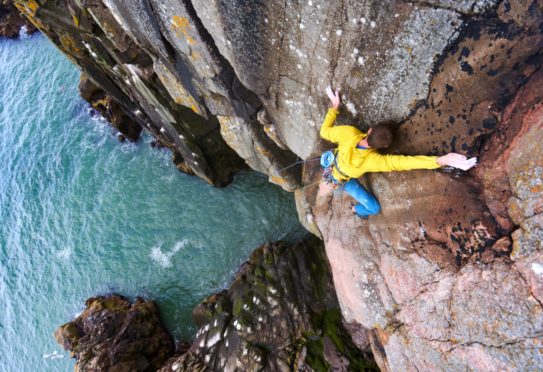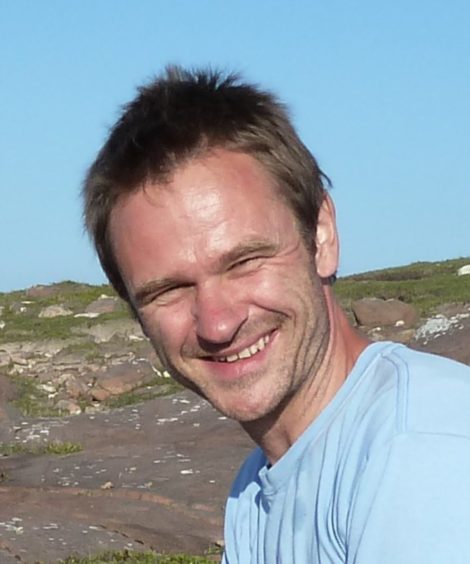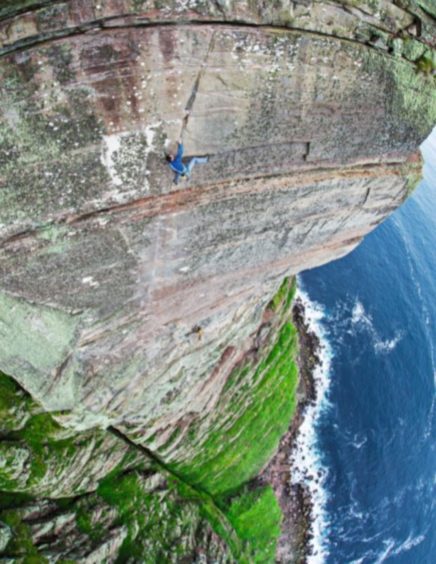
Located somewhere between land, sky and sea, Scotland’s sea cliffs are a terrain so high, vast and dangerous that only creatures with wings would seem equipped to go near them.
But climber and author Guy Robertson’s collection of outrageous climbing adventures from 26 of the most extraordinary sea cliffs across Scotland suggests otherwise. His book, The Great Sea Cliffs Of Scotland, features contributions from some of the world’s most renowned climbers, traversing the archipelagos from the Outer Hebrides to the Aberdeenshire coast, while tracing the remarkable history of Scottish sea-cliff climbing and offering a glimpse into its future.
Robertson has been at the forefront of Scottish climbing since his teens, and has completed climbs in regions as diverse as Africa, the Middle East, the Alps, Peru, Norway and the Greater Himalaya.
But it’s his domestic climbs he reveres – and it’s the sheer scale of Scotland’s sea cliffs that means they are revered by climbers around the world.
“Sea cliffs cover a huge proportion of Scotland’s 10,000km of coastline, which at their highest soar over a thousand feet from the ocean below,” he said.
“We also have over 900 islands – it’s almost too much to get your head around. It’s unbelievably diverse so, from a climbing point of view, it’s almost never-ending.
“There are also still so many places that haven’t been climbed by anyone yet, so it’s got that potential for exploration too, which climbers always love.
“We also have the reputation internationally of being really adventurous for climbing because in a lot of other countries it’s acceptable to drill bolt holes into the rocks to help climbing, but in Scotland that’s unacceptable. So you’re responsible for your own safety and protection,” he added.
While survival on sea cliffs is something climbers must think about each time they brave the terrain, sea cliffs themselves were integral to the survival of many Scottish coastal communities historically, most famously perhaps in St Kilda. “The people in these communities were so rooted in their environment, the only thing they imported, I think, was salt,” said Robertson.
“The people in St Kilda, for example, relied so heavily on the cliffs for eggs, for birds and their meat and feathers and they would climb these unbelievable cliffs and stacks in their bare feet.
“It was highly dangerous obviously, but that connection between us as people and the landscape is still something I think that resonates with climbers and keeps them going back for more.”
Guy’s top five
From daunting 1,000-ft walls of rock to stunning vistas and short, steep challenges, Guy Robertson’s The Great Sea Cliffs Of Scotland features accounts by some of the world’s best climbers of their most spectacular sea-cliff climbs in Scotland. Here are five of the most memorable
Evolving from a necessity to a pastime, climbing for fun began in the age of exploration in the Victorian era, and has evolved drastically over the past few decades, as technology and mapping of sea cliff evolves.
“Climbing is so much more revered now as an extreme sport – this would have actually been its first year in the Olympics, so it’s being taken much more seriously,” said Robertson.
“I think people do have this idea in their heads that you have to be a bit nuts to climb these huge rock faces but, in reality, it’s actually pretty safe.
“Other extreme sports like mountain biking and skiing are far more dangerous because if you fall, you fall and that’s it.
“With climbing, because it would be so dangerous without planning – you are really safety conscious. You’re constantly checking your ropes, making sure everything is in place.
“It’s very methodical and considered, and quite often you’re following a route that’s been done before, so it’s all very clinical and calculated and there’s actually very rarely any fatalities.
“Films like Free Solo, where they’re free climbing in places like Yosemite without any ropes is something I think people tend to associate with normal climbing – but it’s definitely something most climbers I know would look at and think ‘what a lunatic!’”
He added: “I think as well, people imagine it’s terrible for your nerves, but in reality it’s really good for your mental health. It’s like a meditation because when you’re up there the only thing you can focus on is the climb. Everything else disappears.”
Free Solo and other documentaries such as The Dawn Wall are popular on Netflix and as interest in climbing grows so, too, does the chance for it to become more mainstream and accessible to those perhaps not as respectful of the environment as Robertson would hope.
“There’s an island called Pabbey in Mingulay which is in the most southerly Hebrides. You go down past Barra and keep going but, even though it’s so remote, it’s actually become quite popular now,” he said.
“When I went there last, I was quite shocked by not just the sheer numbers, but that people had brought their dogs with them and it just all felt a bit like it was getting to that stage where it could benefit from a bit of management.
“There’s ground-nesting birds and rare birds who inhabit these islands who need to be protected.
“I suppose it’s like anything – the more popular something becomes, the more you have a section of society who don’t have that affinity to make sure they’re taking care of the environment they’re in.
“As climbers, you have a responsibility to learn what’s in these places, so you’re not disturbing wildlife or destroying habitats.
“You see all the stuff about wild campers and people just not respecting and littering – I’d hate for these amazing areas of beauty we climb in to end up that way, because these really are some of the most unique places we have in the country.”
The Great Sea Cliffs Of Scotland, by Guy Robertson, is available at scottishmountaineeringpress.co.uk

Enjoy the convenience of having The Sunday Post delivered as a digital ePaper straight to your smartphone, tablet or computer.
Subscribe for only £5.49 a month and enjoy all the benefits of the printed paper as a digital replica.
Subscribe © Supplied
© Supplied © Lukasz Warzecha
© Lukasz Warzecha